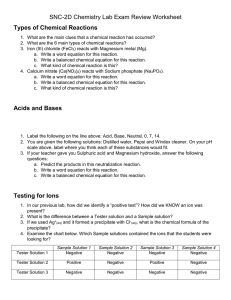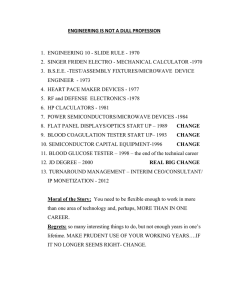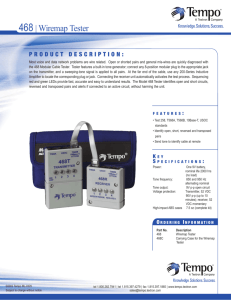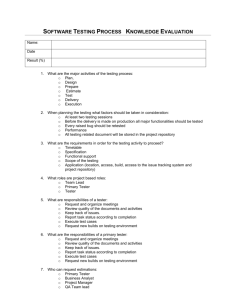!PRELIMINARY EVALUATION Of A VACUUM-INDUCED CONCENTRATED-LOAD SANDWICH TESTER No. 1832-A
advertisement
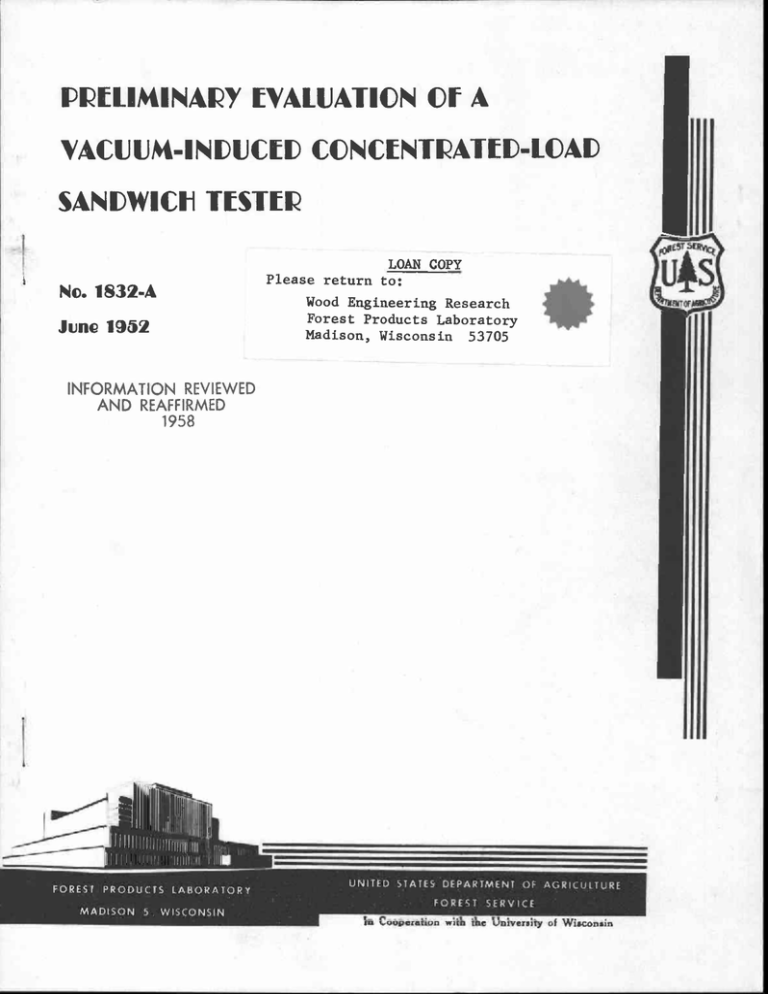
!PRELIMINARY EVALUATION Of A VACUUM-INDUCED CONCENTRATED-LOAD SANDWICH TESTER LOAN COPY Please return to: No. 1832-A Wood Engineering Research Forest Products Laboratory Madison, Wisconsin 53705 June 1952 INFORMATION REVIEWED AND REAFFIRMED 1958 111 FOREST PRODUCTS LABORATORY UNITED STATES DEPARTMENT OF AGRICULTURE FOREST SERVICE MADISON S. WISCONSIN In Cooperation with the University of Wisconsin PRELIMINARY EVALUATION OF A VACUUM-INDUCED CONCENTRATANIOAD SANDWICH TESTER By W. S. ERICKSIIT, Mathematician E. W. KUENZI, Engineer and B. G. BEEBINK, Engineer 2 Forest Service Forest Products Laboratory, – U. S. Department of Agriculture .LumnLz ar • This progress report presents a description of a testing device designed to aid in the inspection of aircraft sandwich constructions. Included is , a discussion of the performance of the tester on a limited number df sandwich constructions. Results of a theoretical analysis for determining deflections and nezdmum stresses are presented. Suggestions are given for improving the performance of the device. Introduction Increasing use of sandwich construction, particularly fdi'primay structural elements, has created a greater demand for inspection devices td 'determine the quality of sandwich constructions. Various methods have been suggested and some successfully demonstrated to ideate and explore the extent of unbonded areas, Obviously, a testing device would be most useful if a nondestructive test could be made that would not only locate but would also 1 This progress report is one of a series prepared and distributed by the Forest Products Laboratory under U. S. Navy, Bureau of Aeronautics Order No, NAer 01319 and U, S. Air Force No. USAF-18(600)-70. Results here reported are preliminary and may be revised as additional data become available. 2 –Maintained at Madison, Wis., in cooperation with, the University of Wisconsin. Report No. 1832-A Agriculture-Madison evaluate the strength of poorly bonded areas.' 'vacuum tester was devised and patented by an aircraft company.. This vac= tester Was submitted to the Forest Products Laboratory for test at the request of the Air-ForceNavy-Civil Panel 23, Des cri ticn and ithrich Tester The tester consists of a dish-shaped casting, approximately 10 inches in diameter, with a rubber gasket or washer around the outside rim. Figure 1 shows an external view of the device. The gasket is used to form a pressure seal between the tester and a sandwich panel. An internal view of the tester (fig, 2) shows a central rubber-covered steel foot that is pressed against the panel as the dish-shaped cavity is evacuated. Foot sizes of different diameters from 1 to 2 inches in steps of 1/4 inch are supplied so that various ratios of Compression and shear can be applied. The foot is fastened by means of a convenient snap-on fitting to a threaded bolt that extends through the casting. A vacuum gage is attached to the casting to measure the applied load. In use, the tester is operated by placing it on a sandwich panel, adjusting the position of the foot by turning the threaded bolt until the panel contacts both the foot and the rubber gasket, and drawing a vacuum on the casting until failure occurs or until some desired proof load, determined by the setting on the poppet valve, is reached. Exploratory trials of the tester showed that the rubber gasket may be deformed so much, by the deflection of the panel, that the casting makes contact with the sandwich. If this occurs, continued evacuation merely places small additional uniform load on the sandwich with little further deflection. This can be easily demonstrated by applying the tester to a thin sheet of aluminum; the casting makes contact with the sheet at low vacuum and then the sheet is slightly concave around the foot until maximum vacuum is attained. In order to indicate rim contact, a buzzer was introduced in a circuit between the casting and sandwich facing. If a nonconductive facing material is on the sandwich being tested, thin strips of metal foil can be placed on the surface and used in the circuit. If rim contact occurs at low loads, the vacuum can be partially released and the-foot extended toward the sandwich by turning the foot adjusting screw. It was conceivable that some s eh constructions would deform considerably under test with no visible or audible indication of failure. Devised by R. M. Matlock and patented by Lockheed Aircraft Corporation, Licenses for manufacture and use granted to Aircraft:Die Cutters, Los Angeles, Calif., and Zenith Plastics, Gardena, Calif.. Report No. 1832-A -2- Indications of failure might appear on a load-deflection curve. Accordingly, a deflection dial was arranged to read the central deflection of the sandwich with reference to three points located opposite the rim of the tester. The arrangement of this apparatus is shown in figure 3. It was subsequently demonstrated that failure of a balsa core was apparent load-deflection curves (fig. 4), but after failure the load increased until rim contact occurred and eventually increased to maximum vacuum with no audible signs of failure. Stresses Induced Of primary interest are compression and shear stresses induced in the core of the sandwich construction by the concentrated load at the foot of the tester. Failures that may occur in the bond between facings and core can be interpreted in terms of the shearing stress developed in the core. The area covered by the casting and gasket of the tester decreases slightly as the vacuum is increased as a result of deformation of the gasket. The area of the tester used at the Forest Products Laboratory was computed to be 90.76 square inches. From this area the compressive and shear stresses in the core were calculated according to the values in . table 1. The expressions given in table 1 were obtained from approximations of the formulas given in'the appendix of this report. For unusual constructions having either thick facings or extremely soft cores the more exact expressions in the appendix should be used to compute the stresses. Expressions for deflections and facing stresses are also included in the appendix. Experimental Work order to determine whether the tester would perform satisfactorily measuring the quality of sandwich constructions:, a few panels were tested to determine either core shear strengths, the location of unbonded areas, or the strength of poorly bonded areas. In in For more accurate load readings the dial vacuum gage was replaced with a mercury column, shown in figure 3. A needle valve was placed in the vacuum line to permit sensitive adjustment of load application. A preliminary test on a sandwich having 0.012-inch 24ST clad aluminum facings on a core of end-grain balsa wood 1/4 inch thick developed core failures in shear at approximately the shear strength of the balsa as evaluated in shear tests. Load-deflection curves for this construction are shown in figure 4. Preliminary testing on a sandwich panel known to have unbonded areas demonstrated that the tester was capable of detecting the unbonded areas Report No. 1832-A -3- regardless as to whether the unbonded facing was the one on which the tester was applied or whether it was the opposite one. further check on the performance of the tester, two flat panels were tested of each of two sandwich constructions. One panel of each construction was well bonded and one panel was poorly bonded on one side. Poor bonding was obtained by using less adhesive than is required for good bonding. The constructions were (1) 0.020-inch 24ST clad aluminum facings bonded with adhesive 35 to a 1/2-inch-thick core of aluminum honeycomb of 0.003-inch foil formed to 3/8-inch cell size (core 52), and (2) facings of 8 plies of glass cloth 112-114 impregnated with resin 2, wet-laminated to a 1/2-inchthick core of glass-cloth honeycomb of 112-114 cloth formed to 1/4-inch cell size (core 36). As a Each panel was large enough to permit four tests with the tester (two from each side) without overlapping the test areas. Load-deflection curves for the aluminum panel are given for each test in figure 5 and for the glasscloth panel in figure 6. Values of the shear stresses developed by the tester at failure are given in table 2. The average strength values as measured by the tester show that the poorly bonded aluminum panel had approximately 80 percent of the strength of the well-bonded panel and that the poorly bonded glass-cloth panel had approximately 35 percent of the strength of the well-bonded panel. Figure 7 shows a cross section through an aluminum control panel (the two halves laid face to face) that illustrates a typical failure under the foot of the tester, and figure 8 shows a typical bond failure in a control glass-cloth panel. Poorly bonded panels of both types failed in a similar manner, respectively, except that the aluminum panels failed in the poor bond as well as in shear in the core, and the bond failures in the poorly bonded glass-cloth panels were more extensive. After the tests had been made with the tester, the panels were cut into minor coupons to be tested in bending to determine shear strength, and in tension normal to the facings to determine bond strength. The bending specimens were 1 inch wide and were tested under loads applied at two-third points on a total span of 6 inches for the aluminum sandwich and 4-1/2 inches for the glass-cloth sandwich. The strong direction of the core was placed parallel to the span length. Tensile specimens were 1 by 1 inch in cross section. The results of these tests are also given in table 2. The shear strengths as determined for the bending-test coupons were from 30 percent to 70 percent of the shear strengths as determined by the tester. The bending-test coupons were cut from portions of the panel adjacent to the area tested by the tester, and, therefore, this reduction in shear strength may have been due to damage caused by the tester load or may also have been due to stresses caused by the saw when the minor coupons were cut. Shear strengths as determined from, bending tests showed the poorly bonded aluminum panel to have 88 percent of the strength of the well-bonded panel, and the poorly bonded glass-cloth panel to have 19 percent of the strength of the well-bonded panel. Tensile strengths of the poorly bonded aluminum panel were 27 percent of the strengths of the well-bonded panel, and strengths of the poorly bonded glasscloth panel were 11 percent of the strengths of the well-bonded panel. Report No. 1832-A -4- General Observations In the evaluation work on the tester to date, it appears that the device has considerable promise of providing a practical means of proof-loading flat, and possibly curved, sandwich panels to a precalculated stress. The addition of the spring loaded relief valve provides a means for controlling the load to any desired level within the range of 1 to 2k inches of mercury. The accuracy of the load application appears to be about 012 inch of mercury. The trials showed that tests can be made at the rate of 12 to 15 per minute if load-deflection data are not obtained. Conclusions The tester can be used bonded areas in panels to determine the location of unbonded or poorly of sandwich construction. Although the data of this report do not positively show direct correlation, the tester may be used to determine shear strengths of sandwich constructions. In the realm of nondestructive testing the tester should find use in careful application of certain proof loads as an aid in inspection of the quality of sandwich panels. Report No. 1832-A -5- APPENDIX The deflection and the stresses induced in the facings and in the core by the tester have been analyzed by the use of formulasderived in U. S. Forest Products Laboratory Report No. 1828.1 In that report the core and facing materials are assumed to be isotropic and, consequently, the present results are limited to this special case. In order to carry out the analysis, the distribution of load over the foot of the tester must be specified. An attempt has been made to keep the distribution uniform bg covering the foot with a rubber gasket, and it is possible that at small vacuum loads it actually is quite uniform. At large vacuum loads, however, the tester forces the panel to bend, and the load is possibly concentrated more heavily at the rim of the foot than at the center. On the basis of these considerations, the analysis has been carried out for two assumed' distributions, namely, (1) a load uniformly distributed over the foot, and (2) a load concentrated at the rim of the foot. For a given vacuum a uniform distribution yields higher predicted shear stress in the core and lower bending stresses in the facings than a load concentrated at the rim of the foot. It is expected that if the true distribution of load over the foot of the tester could be determined, the results would be intermediate between those of the two extreme cases considered. The formulas given below are derived on the assumptions that the test panel is of infinite extent and that the facings are of equal thickness. Moreover, the formulas are given in forms applicable to a panel with thin facings and with a core that, like end-grain balsa, has a relatively high shear modulus. Specifically, it is assumed that as andab j defined below, are so large that the Bessel functions that appear in formulas taken from Report No. 1828M can be expressed in the forms (64) and (65) of that report, and that the quantity e - 04.b) can be neglected in comparison with unity. It is believed that these conditions will be fulfilled for most constructions that are likely to be of practical interest. The deflection and the components of stress in the facings and in the core are given in terms of the following symbols: a: radius of the tester gasket b: radius of the foot c: thickness of the core Ef 5:772 S. Ericksen. The Bending of a Circular Sandwich Panel under Normal Load. Report No. 1832-A -6- E Young's modulus of the facing material f' f: thickness of the facings G: shesYlaodulus of the core material I m + If I f)2 I - f( -m It = 2 f3 r- si : applied a2 vacuum (p.s.i.) 2GI - &fir Poissons ratio of facing material For a load distributed uniformly over the foot of the tester, the deflection of the sandwich, wu, at the center of the tester relative to the outer rim of the tester-is given by the formula WU° wbU+wsU ( I) where, 5(a 2 • qa2 wbU 64E1 2 WU B 2E1 f a-2 ,2.) • 4b14b2 log -a-1I 171 log a - 2 (2) (3) a2b2 For a load concentrated at the rim of the foot, the central deflection is given by we = (14) win where, 2 /lb w sc .8b2 (1 + log 2..) 64E1 C = n2 2EIfaa Llog b - 2 (3. + L) ab The shear stress in the core evaluated at the rim of the foot is the formula Report No. 1832-A -7- (5) (6) given by TU = 2 c + f (7) i b for a load distributed uniformly over the foot, and by the formula c= 2(c + f) (8) [;'13 for a load concentrated at the rim of the foot. The stress at the outer surface of the facing upon which the tester is placed is evaluated at the rim of the foot by the formula - q(c 2f) 321 mhU,c 4. 16(c + f) (3c + 2f) msUlc f( c + 2f) (9) where the subscripts U and c again designate quantities associated with a uniform foot load and7a load concentrated at the rim of the foot, respectively. For a load distributed uniformly over the foot, mbu = 4(1 + y) a 2 log - (3 +7 ) (a2 - b2 ) msU (1 y) (a2 - b2 ) 22 2a b a2 22 22 b - (10) (1 -7) (11) ab and for a load concentrated at the rim of the foot, ' min- = msc 4(1+v) a2 log t- - 2(1 +y ) a2 11=.7-1 ab ▪ 4. (3 4; 1 +Y n ) b2 (12) (13) a' At the present time a reliable means of estimating the transverse pressure on the core is not available. However, if the load can be taken to be uniformly distributed over the foot, it is estimated that the pressure exerted by the loaded facing upon the core is about one-half the pressure on the foot. Application of formulas Figure 4 shows the load-central deflection curve for a test panel to which the preceding formulas are applicable. The results given below were Report No. 1832-A obtained from computations, measured, was complete list a these formulas for a foot diameter of 1-3/4 inches. In the the shear modulus of the core material, which was not taken as 20,000 pounds per square inch. The following is a of the dimensions and elastic properties used. 5.38 inches b = 0.875 inch c = 0.25 inch Ef = 107 pounds per square inch f = 0.012 inch G = 2 x 104pounds per square inch Y = 0.3 These yield E = 1.1 x 107 pounds per square inch I4:4= 4.12 x 10 -4 inch3s3 If = 2.88 x 10-7 inches3 I = 4.12 x 10 -4 inches3 a = 41.6 From (2) and (3) it is found that the deflections are given by ybU = 0.0135 q (14) and wsU = 0.0049 q Therefore, if the load is uniformly distributed over the foot, the central deflection obtained from (1) is wu = 0.0184 q (p.s.i.) = 0.0090 a-(in. HG) (35) Similarly, from (5) and (6) wbc = 0.0127 q and (16) vac = 0.0034 q Report No. 1832-A so that for a load concentrated at the rim of the foot) (4) yields c 0 = 0.0161 q(p.s.i.) = "079 q (in. HG) (17) Formulas (15) and (17) yield, respectively, q (in. HG) = 111 wu and q (in, HG) = 127 we (18) The slopes of the line:, represented by these equations would change slightly if the shear modulus of the core was changed and if the radius of the tester, which presumably decreases with increasing load, was varied. They are, however, of the same order of magnitude as the slopes of the linear portions of the two curves in figure 4 for the foot diameter of 1-3/4 inches, which are 125 and 132. It is of interest to observe that the deflections duo to shear represented by wsu and wsc are about one-third of the deflections due to bending represented. by deformations for an aluminumwbU and wbc . These relatively large shear balsa panel are attributed to the small dimensions of the area of the panel over which deflection takes place. The shear stress in the core obtained from (7) and (8) are, respectively, TU = 60 q (p.s.i.) = 29 q (in. 110) and 30 q, lia.s. i .) = 15 q (in. HG) The stress predicted on the basis of a uniform load on the foot is thus about twice as great as that obtained by taking the load to be concentrated at the rim of the foot. For the present core and facing thicknesses, formula (9) for determining facing stresses takes the form (21) a 540 .-20.8qm--20,300 -sSU,c ou,c From formulas (10) to (13) 20.8 mbliq = 3760 q (22) 20,300 msuq = 267 q (23) 20.8 mbcq = 4170 q (24) 20,300 mscq = 3950 q (25) Report No. 1832-A -10- Table 2.--Strengths of panels as determined by the tester : Tensile strength: Well-bonded : Well- : Poorly Poorly bonded panel : bonded : bonded panel : panel : panel Tester : Bending : Teeter : Bending : : test : : test Shear strengths (1) P.s.i. : (2) : (3) : P.s.1. : : (4) : P,,s.i.: P.s.i. : (5) : (6) P.s.i. : P.sri. San(Wich Construction: Facjngs 0,020-inch 24ST Clad -----....—............ Aluminum Core -- 1 2-inch-thick Aluminum Honeycomb 91.—.C2003-inchPoil-Form= 191 : 78 : 242 211 .• . 95 : 204 •. : 86 175 : : • • •• • ga.63 : R170 : 76 156 : • 37o 330 179 : 163 : 142 : 196 170 : 56 •. 163 : : 110 110 350 : 100 320 : 70 : 310 : 7o • 230 : 60 23o : _ 70 : 6o • : 50 : s60 280 : 50 • 270 : 80 • 300 : 270 250 : : 110 100 100 • : ' • • 4ielle: • 'oo..4;;. . . . • • 1 • • • •• • OSOG 4400 lei 340 boo ' 340 ....o os . 300 -.• 135 : 3:10 310 • Av. 212 : • 280 • • .., • • • 25o 270 166 : 119 296 8o (Sheet 1 of 2) Report No. 1832-A Table 2.- . 21.11aagalLmas as determined by221. tester (Cont.), : Tensile strength Shear strengths : Well- : Poorly : bonded : bonded : panel : panel . Tester : Bending : Tester : Bending : : • test : test : : Well-bonded panel (1) : (2) • Poorly bonded panel : (3) : (4) : (5) (6) : : P.s.i. : P.s.i. : P.s.i. : P.s.i. P.s.i. : Sandwich Construction: Facings -- 8 plies of Glass tila/3 71-thiclt Glass-cloth Honeycomb of 112 Cloth Formed to 16:inch Cell Size.2 451 : 18o : 3146 : 544 : 252 : 3213 : 521 •. 34o : . 151 : 515 : 354 : 185 : : • • 226 : 282 : • : • : 38 66 5o 52 • 310 : 270 25o : 24o 0 4o 42o 3o 220 340. 290 300 230 250 240 0 20 : • • ...... ....: : : . • • • • • , • . • " .. .....4.,!....: . . ? .. : • . Av. • 506 • : 272 : •• • • • : 340 280. •290, . 300 .•041100 : • .. 280 320 290 300 : 290 • • . 174 .• 52 6o 20 50 50 50 ▪ • : • : : • 32 –Tested with a 2- inch- diameter foot. -Tester on poor-bond side of sandwich. 'Tested with a 1-1/2-inch-diameter foot. (Sheet 2 of 2) Report No. 1832-A Figure l.--External view of the sandwich tester, showing rubber gasket, attached vacuum line, and vacuum gage. The center bolt extends to the interior foot. An auxiliary poppet valve has been installed (immediately below the gage on the photograph) for control of vacuum during use as a tester. 2m 88041 F Figure 2.--Internal view of the tester, showing the central foot and alternate foot sizes available for use. The cantilever spring actuating the poppet valve for control of vacuum is also shown. z M 88040 F Figure 3.--The tester in use during evaluation tests, showing the addition of a deflection-measuring device on the opposite facing. z M 88038 F 4:1 a •,-C8 9 0 g w5 0 ao S •ri 9-1 ,d ao rd PI 45 0 o 9-1 o 4-1 q O 0 O 0 eclj 0 g nri 1 ta A . . O p co o $ 1 an CD H 0 CJ gi i ,—. 4j t— k 0 H q F-1 0 v -P p4 • co 8.--Typical failure in a control glass-cloth panel. Failure is confined to the bond between the facing and the core on the side opposite the tester. Figure z M 88863 F

